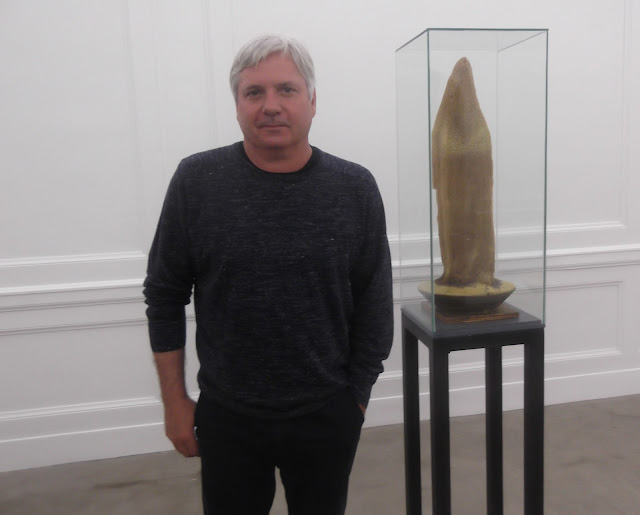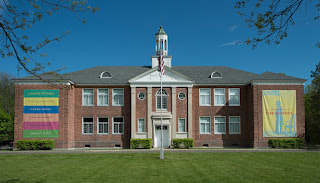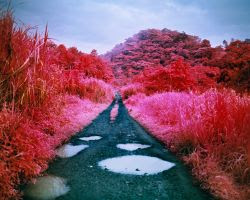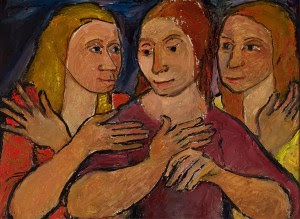The School, Shainman Gallery, Kinderhook, NY
Dorion, Puett, Jack Shainman, Carlos Vega, Mosse
GREAT exhibition! Best yet. "Well, I see u have a PS1 Moma right here" said one visitor today to Jack Shainman's anniversary party at The SCHOOL, Kinderhook. Celebrating the 2nd b-day of his knock-out vast upstate gallery, Jack selected 4 artists, (3 men, 1 woman,) from Ireland, Iraq, Canada & Hawaii who work across photography, painting, sculpture, installation, site specific pix & video.
THE RESULT IS TERRIFIC! Memorable. Impressive.

The star here is RICHARD MOSSE, an Irish artist now based in NY.
For photographer RICHARD MOSSE pink is not a pretty colour.
The results are breathtaking, & installed in Kinderhook's prime space (the largest photograph is 24ft x 14ft) quite awe inspiring.
Moss told me, "It's the last venue for the series, & I wanted to end it on an optimistic note, even show the Congo's tourist potential. In the 1950s before Mobutu there was tourism, not surprising when you see the extraordinary landscape."
After years of restrained, objective views of Iraq, (Saddam Hussein's former palaces - he had 84! - occupied by US military.) Mosse turned to war-torn Congo devastated by rebel fighters & ecological plunder.
By shooting in old Kodak surveillance & reconnaissance film that turns jungle greens into lush bubblegum pinks & reds, he gives us a panoramic vision of bloody beauty overload coupled with terror.
The results are breathtaking, & installed in Kinderhook's prime space (the largest photograph is 24ft x 14ft) quite awe inspiring.
Mosse, now 36 & NY based, is Irish, from Kilkenny. After Goldsmiths & Yale, in 2013 he represented Ireland at the Venice Biennale.
Visitors start with the unusual. GARNETT PUETT works with bees & his remarkable surreal sculptures fill the entrance while upstairs 2 separate bee colonies are at work turning their specially constructed artistic hives into art.
Sculpture and the lost wax process of casting are old friends so it was a short step to his metal armatures & geometric forms embellished by the intricate organic beeswax honeycombs.
"Bees like to aim for the top of the hive," he told me, "So it all depends on where I put the queen." His "hives" range from garbage can lid to a gun cabinet titled Perfection. Here a tube leads out to the Hudson Valley countryside where the bees collect their pollen.
"Bees like to aim for the top of the hive," he told me, "So it all depends on where I put the queen." His "hives" range from garbage can lid to a gun cabinet titled Perfection. Here a tube leads out to the Hudson Valley countryside where the bees collect their pollen.
A fabulous collaboration of artist, bees and creativity.
HAYV KAHRAMAN originates from Iraq but left for Sweden at 11.
Trained in Italy, now based in LA, her work has a decorative slant combining elegant Islamic script & female form.
This new work includes intricate pattern & pierced canvas across the women's chest.
Evidently the openings are filled with acoustic foam, an absorbent shield against high decibel siren noise used as a weapon in war, but this too subtle concept & imagery is lost in the overall design.
Better are her sculptural versions with overlapping screens as found in Arabic homes, & her large sculpture which takes these ornate ornamental perforations to another level.
French Canadian painter PIERRE DORION presents work site specific to the School.
Last November he came to Kinderhook & took photographs of its numerous interior spaces, including a couple of unfinished rooms where the work now hangs.
Last November he came to Kinderhook & took photographs of its numerous interior spaces, including a couple of unfinished rooms where the work now hangs.
Dorion is fascinated by spaces: windows, doors, screens, geometric & infinite in permutation.
VERY Best show yet at The School. The show runs to October 1st. There are also 2 Shainman galleries in Chelsea NY.
Pierre Dorion, Clare Henry, Ricard Mosse in Kinderhook. May 22, 2016.

























